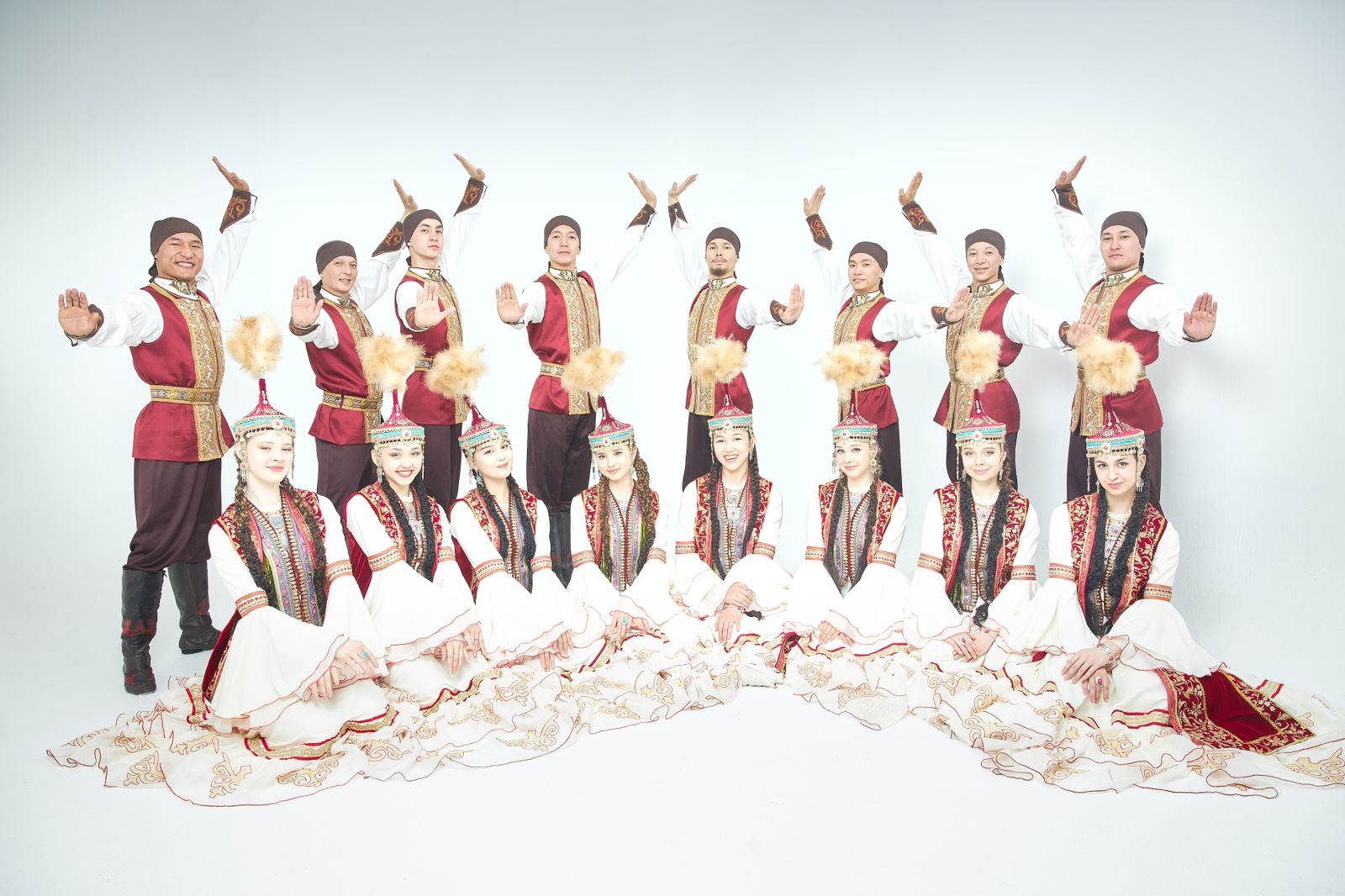ASTANA—The Kazakh folk dance ensemble Birlik (Unity), representing a unique combination of international folk dances and live music, aims to become a benchmark of excellence and professionalism in music and a symbol of harmony and cultural diplomacy, said Anel Marabayeva, the choreographer and artistic director of the ensemble, in an interview with The Astana Times.

Kazakh folk dance ensemble Birlik (Unity). Photo credit: Anel Marabayeva / Birlik ensemble.
The initiative to create Birlik was spearheaded by Kazakh Minister of Culture and Information, Aida Balayeva, on March 1. It aims to act as a bridge to cultural understanding in diversity and reflect the strength of Kazakhstan’s multinational people. The project engaged multinational choreographers and musicians to collaborate and share experiences, enriching the ensemble’s global perception.
Operating under the QazaqConcert, directed by Tair Karateyev, Birlik integrates creative groups such as Gulder, Astana Musical, and Astana Sazy. Each performance features a unique blend of national dances, live music, and folk instruments.
Vibrant repertoire, vivid Kazakh dance
Birlik’s repertoire includes Russian, Korean, Uzbek, Kyrgyz, Tatar, and Kazakh national dances.

Anel Marabayeva, the choreographer and artistic director of the Birlik ensemble.
“For example, for the Uzbek dance, we incorporated karnai players. It is a long national brass musical instrument. Tatar dance was accompanied by the Astana Musical choir,” said Marabayeva, noting that the Astana Sazy orchestra generally accompanies all their performances.
Marabayeva discussed the upcoming international competition in Türkiye in July, with participants from 40 countries.
“We will represent Kazakhstan and perform four Kazakh dances: Zhiger, Kui Shashu, Mereke Bi, and Qazaq Batyrlary, as well as my solo dances Akku and Shara,” said Marabayeva, describing each performance.
Zhiger (The Vigor) is a modern neo-dance with elements of ballet and classical dance. “Kui Shashu, staged by Azhibekova Zaure, is a festive dance with rich costumes,” she added. Kui is Kazakh national music, traditionally played on dombra or kobyz, while Shashu, translated as scatter, is a Kazakh tradition where guests are lavished with sweets and money. Together, the idea of the dance performance lies in the artists, endowing the audience with rich music, dance, and festiveness.
Mereke Bi (Celebration Dance) is a cheerful and fast dance included in the golden fund of national culture. Kazakh Batyrlary is a dance performed by men that demonstrates the strength and courage of Kazakh batyrs (warriors). It combines elements of Qazaq Kuresi (wrestling), horse racing, and a horse’s gait.
“These are all new performances staged by an incredibly talented choreographer, Gumar Sultanbek. He dances at the Astana Opera and stages very beautiful dances to the music of the Hassak group,” said Marabayeva.
When asked about her solo dances, Marabayeva explained that Shara is a dance dedicated to Shara Zhienkulova’s legacy.
Shara Zhienkulova, the first Kazakh professional dancer, is considered the founder of Kazakh professional choreography. She drew inspiration from the people and created her own dance masterpieces. Marabayeva explained that Zhienkulova had a student, Beisenova Gainikamal.
“Beisenova, a leading teacher of Kazakh dance, inherited Zhienkulova’s school to share knowledge about Kazakh dance with the next generations (…) And I am the student of Beisenova Ganikamal, making me like Zhienkulova’s granddaughter,” said Marabayeva.
The second solo dance, Akku (Swan), is an exquisite and graceful performance characterized by smooth, flowing movements that mimic the swan’s movements. The main feature of the Kazakh Akku is the unique arm movements representing the swan’s neck, head and wings, each performed to the beats of kui, which also represent sounds that the swan makes.
“We are working on including it as an intangible heritage of UNESCO, because the Kazakh Akku is truly unique. There are no such elements, hand movements, and costumes in any other culture. Except for Maya Plisetskaya’s dying swan, but that is a ballet interpretation,” said Marabayeva.
Significance and sacredness of Kazakh dance
Kazakh dance holds a deeper meaning, reflecting people’s way of life, holidays, and imitation of the animal world, influenced by the Tengrianism in Kazakh history.
“Kazakh dance is deeply sacred, embodying more than just a series of movements. It reflects the manifestations of nature and the surrounding world. Each movement in Kazakh dance can be associated with one of the five elements: water, fire, earth, air and ether,” said Marabayeva.
One fundamental movement in Kazakh dance is Tolkyn (wave), symbolizing water with graceful hand and finger motions. Another is Kamazhai, professionally termed either Kos Kol (double hands) or Ainalma (turning around or spinning around).
“In the Kazakh language, we do not have the word for dying. We have Kaitys Bolu, suggesting coming back and continuity rather than the end. The Ainalma movement, with its rotating gesture, symbolizes the infinite cycle of life, emphasizing that existence is in constant motion,” Marabayeva explained.
Kazakh dance uses hand movement to depict elements of nature and culture, such as a bird, snake or Koshkar Muiz (ram’s horns). Men’s dances portray fearless, courageous and powerful imagery. In contrast, women’s dances highlight beauty through gestures like Bilezik (bracelet) or Syrga (earrings) and their inner strength by displaying a soft but powerful swan or riding a horse.
“At the moment, I am working on a project to create images of Kazakh women through dance, starting with the goddess Umai, legendary Tomiris, the mother of the Great Steppe, Bopay Khanum, and young Kelin (bride) dance,” said Marabayeva.
She aims to elevate women’s importance in Kazakh culture, showcasing their resilience and capability to inspire reforms through gentleness and strength, countering any notion that women are valued only for comfort. This initiative will honor traditional Kazakh dance while embracing contemporary expressions.
Birlik ensemble’s formation and recruitment process
Karlygash Azhieva, an Honored Worker of Kazakhstan and an organizer of theatrical mass and private events led the ensemble’s formation and recruitment. “I personally refer to her as the Grey Cardinal of Kazakh art for her influence and expertise. She has been organizing mass concerts in Kazakhstan for 20 years and is well-connected with the country’s top artists,” said Marabayeva.
“We had one month to cast, find dancers, sew costumes and invite choreographers, working around the clock to accomplish everything,” she added.
The Kazakh National Academy of Choreography and Astana Opera Academy were the key partners contributing to the ensemble’s formation. “This is a colossal and very high-profile project. It was a lottery ticket for these young artists as they joined a presidential team,” said Marabayeva.
She noted that the ensemble plans to expand from eight couples to 16, with ongoing casting to double the current number of dancers.
After the recruitment, their main balletmaster, Kozhabekov Zhanatai, trained the team, focusing on rotations, muscle strength, and stretching. “You need strong discipline like in any other sport. We prepare artists for the professional stage like athletes prepare for the Olympic Games,” shared Marabayeva.
The Birlik ensemble performs primarily at state events such as high-level meetings, forums, international celebrations, and diplomatic visits. In her revelations, Marabayeva shared that the ensemble is seeking sponsors due to budget constraints exacerbated by massive floods in the spring across the country.
“We aim to collaborate with firms such as Air Astana, KazMunaiGas, or Kazakhmys, offering performances at company events like Miner’s Day or Oilman’s Day in exchange for support,” said Marabayeva.
“Renowned Zhienkulova had a miner’s dance, so why not create an oilman’s dance or pilot’s dance? We want to support through art and create mutual collaboration,” she added.
Backstage atmosphere and performance mindset
Marabeyva graduated from the Almaty Choreographic College, named after Alexander Seleznev and furthered her education at Zhurgenev University and Shabyt. She completed her master’s at the Kazakh National Academy of Choreography in Astana.
Throughout her career, Marabayeva has excelled as a solo dancer. She has been a member of the Presidential Orchestra and a solo performer at the National Dance Theater, frequently invited to perform and represent Kazakhstan globally.
She noted that the atmosphere backstage mixes excitement and anticipation before performances. Marabayeva’s guiding principle for the performers is to dance not just for the audience but for a higher purpose.
“For me, dancing is a kind of dialogue with God. This is my vision and I’m broadcasting it to the team,” said Marabayeva.
She highlighted the importance of conveying love and joy to the audience with genuine smiles and passionate performances, celebrating life and sharing that joy with others.


